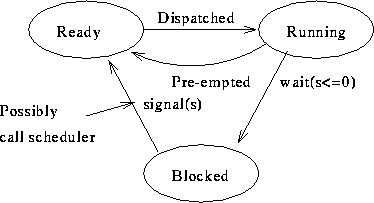Process Synchronization Mechanisms
Tom Kelliher, CS 318
Feb. 4, 1998
Announcements:
From last time:
- Nachos internals.
- The critical section problem.
- Producer/Consumer model.
- Disabling interrupts as a primitive solution.
Outline:
- Cooperating processes (review).
- A hardware solution to the C. S. problem.
- Semaphores.
Assignment: Read Chapters 4 and 6.
- Must cooperating processes synchronize under all conditions? (Don't
forget single writer performing atomic writes/multiple readers.)
- What does atomic mean?
- Recall necessary and sufficient conditions: Mutual exclusion,
progress, and bounded waiting.
TAS: Test And Set. Semantics:
int TAS(int& val)
{
int temp;
temp = val; // Body performed atomically.
val = 1;
return temp;
}
A partial solution to the critical section problem for n processes:
// Initialization
int lock = 0;
void MutexBegin()
{
while (TAS(lock)) // Ugh. A spin lock.
;
}
void MutexEnd()
{
lock = 0;
}
Prove that this is a solution to the C. S. problem.
- Created by Dijkstra (Dutch)
- A semaphore is an integer flag, indicating that it is safe to
proceed.
- Two operations:
- Wait (p) --- proberen, test:
wait(s) {
while (s == 0)
;
s--;
}
Test and (possible) decrement executed atomically (usually achieved
through hardware means).
- Signal (v) --- verhogen, increment:
signal(s) {
s++;
}
- Why not resort to hardware methods?
- These are operations provided by the kernel. Wait and signal are
atomic operations.
- Critical section solution:
semaphore mutex = 1;
mutexbegin: wait(mutex);
mutexend: signal(mutex);
- Mutual exclusion is achieved: consider a contradiction.
- Progress is achieved: someone got the semaphore.
- Bounded waiting depends on how the wait queue is implemented (if
at all).
- Interrupt signalling:
semaphore sig = 0;
int_hndl:
signal(sig);
driver:
startread();
wait(sig);
- Process synchronization:
semaphore flag = 0;
process1()
{
p1Part1(); // This will complete before p2part2() begins.
signal(flag);
p1Part2();
}
process2()
{
p2part1();
wait(flag);
p2part2();
- Resource management (pool of buffers)
Producer/Consumer problem:
semaphore count = N;
semaphore mutex = 1;
getbuf:
wait(count); /* order important here */
wait(mutex);
<grab unallocated buffer>
signal(mutex);
return(buffer);
relbuf:
wait(mutex);
<release buffer>
signal(mutex);
signal(count);
- Above semaphores inefficient --- spinlocks. Let waits which cause
busy waits actually block the process:

Associate a ``blocked'' queue with each semaphore.
typedef struct semaphore {
int value;
pcb *head;
}
Semaphore creation:
semaphore *createsem(int value) {
semaphore *sem;
sem = get_next_sem();
sem->value = value;
sem->head = NULL;
return (sem);
}
void wait(semaphore *sem) { /* need mutex goo here */
if (--sem->value < 0) {
<update status of current process>
insqu(sem->head->prev, current);
scheduler();
}
}
void signal(semaphore *sem) { /* mutex */
pcb *proc;
if (++sem->value <= 0) {
proc = remqu(sem->head->next);
<update status of proc>
ordinsqu(ready, proc);
if (proc->prio > current->prio)
scheduler();
}
}
Thomas P. Kelliher
Mon Feb 2 09:20:02 EST 1998
Tom Kelliher
